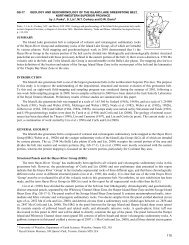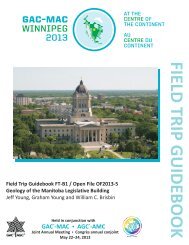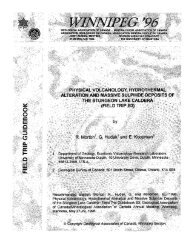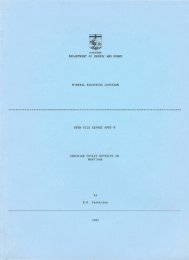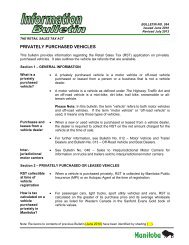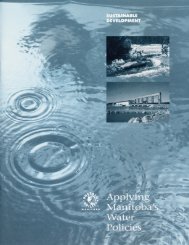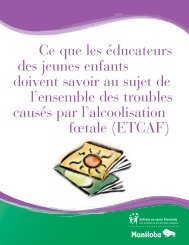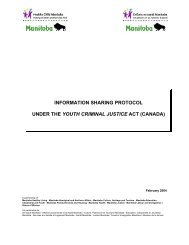Nutrient Management Strategy - Government of Manitoba
Nutrient Management Strategy - Government of Manitoba
Nutrient Management Strategy - Government of Manitoba
You also want an ePaper? Increase the reach of your titles
YUMPU automatically turns print PDFs into web optimized ePapers that Google loves.
Information Bulletin2000 - 02E<strong>Manitoba</strong>ConservationApril 20, 2000Development <strong>of</strong> a <strong>Nutrient</strong> <strong>Management</strong><strong>Strategy</strong> for Surface Waters in Southern<strong>Manitoba</strong>ForewordOne <strong>of</strong> the greatest challenges facing water quality managers in the prairie and southern portion<strong>of</strong> the boreal forest regions <strong>of</strong> Canada and the northern United States is to better understand and tocontrol, where necessary, the introduction <strong>of</strong> plant nutrients into surface waters. Prairie soils tend to benaturally rich in nitrogen and phosphorus, streams may be turbid thus limiting light penetration, andphosphorus - the nutrient most easily controlled from point-source discharges - may not be the factor thatlimits algal growth in many prairie water bodies. Eutrophication <strong>of</strong> surface waters is a scientificallycomplex process and nutrient management options can be difficult and costly to implement.The purpose <strong>of</strong> this draft document is to outline the main tasks and issues that need to beconsidered and addressed as a nutrient management strategy is developed and implemented. Yourcomments and suggestions on the attached draft are welcomed as we proceed to develop and toimplement a nutrient management strategy.Please forward comments on the attached draft by June 30, 2000 to the following:Dwight Williamson, ManagerWater Quality <strong>Management</strong> Section<strong>Manitoba</strong> Conservation123 Main Street, Suite 160Winnipeg MB R3C 1A5Telephone: (204) 945-7030Toll Free: 1-800-282-8069 (7030)Facsimile: (204) 948-2357E-mail: dwilliamso@gov.mb.caPlease feel free to contact Dwight Williamson should you require further information.For Additional Information, Visit <strong>Manitoba</strong> Conservation’s Website for Current Issues - Latest Newswww.gov.mb.ca/environ/
Page 1IntroductionEutrophication is one <strong>of</strong> the most importantwater quality issues in the prairie and boreal plainecozones in western Canada. Water qualitymonitoring results indicate that most <strong>of</strong> the largeriver systems that flow across the prairie andboreal plain ecozones contain relatively highconcentrations <strong>of</strong> phosphorus and nitrogen, thetwo nutrients most commonly associated witheutrophication. The main factors that maycontribute to the high nutrient content in thesesystems include erosion <strong>of</strong> naturally fertile soils,surface run-<strong>of</strong>f <strong>of</strong> fertilizers from cultivated fields,run-<strong>of</strong>f from livestock pasture and feedlots, urbanrun-<strong>of</strong>f and storm sewer discharges, andagricultural, industrial, and urban sewage effluentdischarges. Some <strong>of</strong> the larger river systems thatare <strong>of</strong> particular concern to southern <strong>Manitoba</strong>include the Assiniboine, Souris, and Red Riversystems, all <strong>of</strong> which carry significant amounts <strong>of</strong>nutrients into the province from the west andsouth.Concerns have been raised over the potentialfor eutrophication processes to not only negativelyimpact rivers and streams that flow through theregion, but also adversely affect the water quality<strong>of</strong> Lake Winnipeg, since the lake is the eventualrecipient <strong>of</strong> the nutrient load transported by many<strong>of</strong> these rivers and streams.growth <strong>of</strong> opportunistic species, resulting in anoverall decrease in biological diversity across theentire ecosystem. As well, the decay process thatfollows the decline or die-<strong>of</strong>f <strong>of</strong> algal andmacrophyte populations uses up large amounts <strong>of</strong>dissolved oxygen. This can have seriousconsequences on aquatic animals, such as fish andinvertebrates, which rely on an adequate supply <strong>of</strong>dissolved oxygen for survival. Low oxygenconcentrations also result in the release <strong>of</strong> thenutrient phosphorus from the sediment, making itavailable for algal growth. Eutrophication mayalso decrease the suitability <strong>of</strong> a water supply fordomestic use (including human drinking),livestock watering, and recreational use. Algalblooms associated with eutrophic waters are <strong>of</strong>tendominated by species <strong>of</strong> blue-green algae, some <strong>of</strong>which are known producers <strong>of</strong> potent nerve andliver toxins. Such a situation can present a healthrisk for humans, household pets, and livestock thatdrink the water, and for people who use the waterfor recreational purposes. There is also someevidence that the toxins produced by blue-greensmay be transferred up the food web, and mayadversely affect wildlife populations such as fishand water birds. Besides being potentially toxic,the presence <strong>of</strong> an algal bloom in a drinking watersource can clog treatment plant filters, and <strong>of</strong>tenimparts an unsightly appearance, and unpleasanttaste and odour to the finished water. Algalblooms and extensive macrophyte growth are alsoconsidered aesthetically unappealing and candetract from the recreational use <strong>of</strong> a surfacewater.The water quality problems that arise as aresult <strong>of</strong> eutrophication <strong>of</strong> drinking andrecreational waters are difficult and expensive toremedy. For drinking water sources the cost <strong>of</strong>additional treatment may be prohibitive in manyjurisdictions, while for recreational waterbodies, adecline in the aesthetic quality <strong>of</strong> the water canadversely affect tourism, and lead to decreasedland and cottage values.<strong>Nutrient</strong> enrichment can directly or indirectlyimpact the water quality <strong>of</strong> surface waters. Anoverabundance <strong>of</strong> nutrients can lead to excessivegrowth <strong>of</strong> algae and macrophytes within anaquatic system, which can greatly alter the overallstructure <strong>of</strong> the ecosystem by favouring the<strong>Nutrient</strong> enrichment has long been recognizedas a major water quality issue. Many importantsteps have been implemented in <strong>Manitoba</strong> andelsewhere to better understand and to implementappropriate and feasible control options. Waterquality objectives were first developed forFor Additional Information, Visit <strong>Manitoba</strong> Conservation’s Website for Current Issues - Latest Newswww.gov.mb.ca/environ/
Page 2phosphorus in the mid-1970s in many jurisdictionsin North America, but were largely focussed onpreventing eutrophication <strong>of</strong> lakes. Theseapproaches have been used in a number <strong>of</strong> cases in<strong>Manitoba</strong>, particularly for bodies <strong>of</strong> water knownto be sensitive to nutrient addition. For example,in several cases municipal and agriculturaleffluents are used for irrigation purposes on eithergrowing crops or parklands as an alternative todirect discharge to streams or rivers, someeffluents are discharged to wetlands or constructedwetlands, and phosphorus-removal technologiesare used in at least one other case. Adoption <strong>of</strong>the recent Livestock Manure and Mortality<strong>Management</strong> Regulation requires the application<strong>of</strong> manure as a fertilizer at agronomic rates. Inaddition, many local stewardship groups andConservation Districts are promoting therestoration <strong>of</strong> wetlands and protective riparianzones as a means <strong>of</strong> both preserving habitat andintercepting run<strong>of</strong>f from agricultural lands.However, despite these efforts in <strong>Manitoba</strong>and similar efforts elsewhere, eutrophicationremains an important water quality issue. This hasprompted many agencies to begin to develop newnutrient management strategies or approachesaimed at controlling excessive inputs <strong>of</strong> nutrientsto surface waters. The Water Quality<strong>Management</strong> Section <strong>of</strong> <strong>Manitoba</strong> Conservationhas responded to the nutrient enrichment issue byidentifying the need for the development <strong>of</strong> along-term nutrient management strategy for theprovince and to begin work towards this strategy.The purpose <strong>of</strong> this document is to identify themain challenges, tasks, and issues that will have tobe considered in the development <strong>of</strong> a nutrientmanagement strategy for waterways in southern<strong>Manitoba</strong>. The Water Quality <strong>Management</strong>Section has already begun to address many <strong>of</strong> theitems outlined below, and will continue to buildonand refine these subject areas as more waterquality data is collected and as information fromsimilar work being carried out in otherjurisdictions becomes available.Item 1 – Eutrophication in Southern <strong>Manitoba</strong>An important first task in the development <strong>of</strong>a nutrient management strategy for southern<strong>Manitoba</strong> is to gather background information onthe current nutrient status <strong>of</strong> waterways in theregion. This task will require the followingactivities:A. Review and compare existing water qualityguidelines/objectives/criteria for nutrientrelated variables (phosphorus, nitrogen,chlorophyll-a, and turbidity) in <strong>Manitoba</strong> andelsewhere.B. Conduct a search <strong>of</strong> the Water Quality<strong>Management</strong> Section database for data on thenutrient related variables phosphorus(including total, dissolved, and orthophosphorus),nitrogen (including ammonia,nitrate-nitrite, and total Kjeldahl nitrogen),chlorophyll-a, and turbidity in samplescollected from water quality monitoringstations in rivers and streams in <strong>Manitoba</strong>.C. Extract, summarize and interpret the data todetermine levels <strong>of</strong> exceedence above existingobjectives and to identify any spatial andtemporal trends in the data. It is important tounderstand whether key nutrients are changingwith time.D. Identify gaps in the existing database.1. Identify any nutrient related variables thatmay be useful in describing the nutrientstatus and degree <strong>of</strong> eutrophication within ariver or stream and that are currentlylacking or insufficiently represented in thedatabase.2. Develop a sampling plan to remedy datagaps. This involves creating a list <strong>of</strong> corevariables for analysis and prioritizingwhich stations to sample and where to addnew stations if required.For Additional Information, Visit <strong>Manitoba</strong> Conservation’s Website for Current Issues - Latest Newswww.gov.mb.ca/environ/
Page 3Item 2 - Derive Numeric Objectives for <strong>Nutrient</strong>VariablesResults from preliminary work on some <strong>of</strong> theissues in Item 1 indicate that the current <strong>Manitoba</strong>Surface Water Quality Objectives and objectivesin place elsewhere in the prairies for nutrients areinadequate. Because <strong>of</strong> this, the derivation <strong>of</strong> newnumeric objectives for nutrient variables is one <strong>of</strong>the first challenges in the development <strong>of</strong> anutrient management strategy for southern<strong>Manitoba</strong>. Numeric objectives, as opposed tonarrative objectives, are important in controllingeutrophication because they allow water qualitymanagers to make informed, scientificallydefensible decisions with regard to regulatingnutrient inputs to surface waters.Two approaches to deriving numeric nutrientobjectives will be used simultaneously. These are:(1) Regional Based Objectives and (2) ObjectivesBased on Receiving Waters.(1) Regional Based ObjectivesThe chemical and physical characteristics <strong>of</strong> awaterway are determined in large part by thefeatures <strong>of</strong> its drainage basin or watershed.Topography, natural vegetation cover, land-usepractices, climate, geology, and soil type can varyconsiderably between watersheds, and as a result,no two waterways are exactly the same in terms <strong>of</strong>flow regime, physical characteristics, and waterchemistry. The growth <strong>of</strong> algae and macrophytesis dependent in large part on the availability <strong>of</strong>phosphorus and nitrogen. However, primaryproductivity in streams is also influenced by lightexposure, temperature, water clarity, flow regime,grazing, the presence <strong>of</strong> toxic pollutants, andmicro-nutrient concentrations, all <strong>of</strong> which varybetween waterways.Given the considerable variation that existsbetween aquatic systems, it is unrealistic that asingle numeric objective for each nutrient variablecould be applicable to all the rivers and streams insouthern <strong>Manitoba</strong>. It is apparent that more sitespecificobjectives are required. Although theestablishment <strong>of</strong> nutrient objectives for individualwaterways is impractical at this time, it isreasonable to consider deriving nutrient objectivesat a regional scale.Regional boundaries for regionally-basednutrient objectives can be based on ecologicalunits such as ecozones or ecoregions, or ondrainage units such as drainage basins orwatersheds. The scale at which the regionalboundaries are set is dependent on the level <strong>of</strong>environmental variability that is deemedacceptable, and the amount <strong>of</strong> the resources thatcan be devoted to the derivation process.Once regional boundaries are established theprocess <strong>of</strong> developing nutrient objectives for theregions can proceed. Major tasks to undertake inthe development <strong>of</strong> regional nutrient objectivesinclude:A. Identify the major problems associated witheutrophication within each region andprioritize which regions and waterwaysrequire the most immediate attention.B. Identify core variables used to assesseutrophication in southern <strong>Manitoba</strong> (these arethe variables for which objectives will beestablished).C. Develop focused monitoring programs orstudies, if required, to better define therelationship between nutrients and primaryproductivity and to identify any temporal orspatial trends in rivers within each region.D. Identify reference streams or reaches thatrepresent ambient <strong>of</strong> non-impacted conditionswithin each region.E. Analyze the data using acceptable statisticalmethods and empirical and simulation modelsto identify relationships between nutrientconcentrations and primary productivity.<strong>Nutrient</strong> objectives have to be scientificallydefensible; otherwise they will be <strong>of</strong> littlevalue when it comes to managing andregulating nutrient inputs to streams and riversfrom point and non-point sources.F. Derive nutrient objectives based on the results<strong>of</strong> the statistical analysis and modelling work.For Additional Information, Visit <strong>Manitoba</strong> Conservation’s Website for Current Issues - Latest Newswww.gov.mb.ca/environ/
Page 4The derivation <strong>of</strong> the nutrient objective valuescan take one or more <strong>of</strong> the followingapproaches.! Objectives may be derived on the basis <strong>of</strong>information obtained from referencestream conditions within each region.! Objectives can be established at levelsbased on predictive relationships betweennutrient concentrations and acceptablelevels <strong>of</strong> primary productivity. (Thisapproach should consider different wateruse objectives - acceptable levels <strong>of</strong> algaemay differ depending on water use withinthe stream/river).! Establish nutrient objectives based onrecommendations in the scientificliterature and on existing objectives andguidelines derived for other jurisdictionsin Canada, the United States, andelsewhere.G. Continue to support work being conductedelsewhere in the prairies, and in particular,eutrophication studies being undertaken by theCommittee on Water Quality <strong>of</strong> the PrairieProvinces Water Board.(2) Objectives Based on Receiving WatersThis approach involves developing objectivesfor waterways based on the effects that streamnutrient loads have on the lakes and reservoirs intowhich they enter.Lake Winnipeg is the recipient <strong>of</strong> much <strong>of</strong> thedrainage in the southern half <strong>of</strong> <strong>Manitoba</strong>. Sincemost <strong>of</strong> the waterways that flow into the lake carrysignificant amounts <strong>of</strong> nutrient, witheutrophication in the southern basin <strong>of</strong> the lakeperhaps approaching conditions observed in LakeErie in the past century (Wood 1999). It ispossible to reverse or halt this process bydeveloping nutrient objectives for streams whichenter the lake that are based on the carryingcapacity <strong>of</strong> the lake itself. In doing so the waterquality <strong>of</strong> the lake and possibly the water quality<strong>of</strong> waterways upstream <strong>of</strong> the lake will beprotected.The derivation <strong>of</strong> nutrient objectives forsurface waters in southern <strong>Manitoba</strong> based on thewater quality and carrying capacity <strong>of</strong> LakeWinnipeg will require extensive studies and datacollection, and detailed statistical analysis andmodelling. The major steps in the processinclude:A. Determine the carrying capacity <strong>of</strong> LakeWinnipeg.B. Determine the amount <strong>of</strong> external nutrientloading that is contributed by rivers andstreams that flow into the lake.C. Determine the maximum acceptable nutrientconcentrations for streams entering lakeWinnipeg. This will be based both on thecarrying capacity <strong>of</strong> the lake and the relativecontribution <strong>of</strong> each stream to the totalnutrient loading to the lake.D. Develop nutrient objectives for rivers andstreams entering the lake, keeping in mind thatthe objectives have to protect the water quality<strong>of</strong> the receiving water, as well as the waterquality and water uses <strong>of</strong> the watercourseupstream <strong>of</strong> the lake.For Additional Information, Visit <strong>Manitoba</strong> Conservation’s Website for Current Issues - Latest Newswww.gov.mb.ca/environ/
Page 5Item 3: Managing <strong>Nutrient</strong> SourcesSome jurisdictions have already developed, orare in the process <strong>of</strong> developing a watershed (ordrainage basin) based approach to nutrientmanagement. The watershed approach involvesfirst identifying all <strong>of</strong> the inputs to the riversystem within a basin or watershed, followed bythe development and implementation <strong>of</strong> strategiesaimed at reducing these inputs. The watershed orbasin management approach is <strong>of</strong>ten multidisciplinaryand requires the cooperation <strong>of</strong> allstakeholders within the watershed. The approachis in keeping with the overall movement towards amore holistic, ecosystem-based approach toenvironmental management.<strong>Nutrient</strong> sources that are discrete observabledischarges are called point sources, while sourcesthat are more diffuse and more difficult to quantifyare called non-point sources.Control <strong>of</strong> <strong>Nutrient</strong> Loading from PointSourcesPoint sources <strong>of</strong> nutrients in southern<strong>Manitoba</strong> include wastewater treatment lagoondischarges, sewage and wastewater treatment plantdischarges, urban storm water drains, andchannelled run-<strong>of</strong>f associated with large livestockoperations. Issues and actions to consider in thecontrol <strong>of</strong> nutrient inputs from point sourcesinclude:A. All point sources <strong>of</strong> nutrients have to beidentified and any information/data aboutnutrient loading from these point sources hasto be gathered. This information can then beanalyzed/modelled along with existing streamnutrient and flow data to ensure compliancewith the nutrient objectives <strong>of</strong> the stream.B. In cases where non-compliance occurs,nutrient control measures such as tertiarytreatment (e.g. constructed wetlands) ornutrient reduction technology (e.g. alumapplications) may have to be considered.C. In the case <strong>of</strong> streams that have multiple pointsources, the sources will be encouraged tocoordinate their discharges in such a way as toensure that stream nutrient objectives are notexceeded and water use is not compromisedduring discharge periods.D. Point source discharges may have to berelocated to minimize negative impacts to thewaterway and to water uses along thewaterway.E. Education awareness campaigns may need tobe initiated that are aimed at reducing nutrientinputs in domestic and industrial wastewater.Control <strong>of</strong> <strong>Nutrient</strong> Loading from Non-pointSourcesNon-point source loading refers to nutrientloading from land surface run-<strong>of</strong>f across awatershed or catchment basin. Non-point sources<strong>of</strong> nutrients in southern <strong>Manitoba</strong> include surfacewater run<strong>of</strong>f from urban areas, fertilized fields,pastures, and livestock holding areas. Run-<strong>of</strong>ffrom non-fertilized lands can also be considered anon-point source <strong>of</strong> nutrients simply because <strong>of</strong>the naturally high soil fertility in some parts <strong>of</strong>southern <strong>Manitoba</strong>. Other non-point sources <strong>of</strong>nutrients include atmospheric deposition andgroundwater seepage.In general, nutrient inputs to a waterway fromnon-point sources tend to be extremely variable,intermittent, and difficult to predict and control.This makes assessing their contribution to theeutrophication <strong>of</strong> a given waterway much moredifficult to ascertain. Some management practicesthat help to control non-point source loading <strong>of</strong>nutrients to waterways include:A. Control <strong>of</strong> run<strong>of</strong>f waters and soil erosion fromagricultural and urban areas through improvedmethods <strong>of</strong> landscaping.B. Use <strong>of</strong> precision farming practices to limit theamount <strong>of</strong> excess chemical fertilizers andmanure applied to cultivated land.C. Preservation or re-establishment <strong>of</strong> riparianvegetation along waterways.D. Restricted access <strong>of</strong> cattle and other livestockto waterways.For Additional Information, Visit <strong>Manitoba</strong> Conservation’s Website for Current Issues - Latest Newswww.gov.mb.ca/environ/
Page 6E. Increased awareness <strong>of</strong> eutrophication in ruralareas with emphasis on the need to change oralter farming practices.F. Increased cooperation, communication, andeducation between government (all levels),producers, conservation groups, and otherconcerned parties.Item 4 – Develop a Geographic Information System(GIS) for the <strong>Nutrient</strong> <strong>Management</strong> <strong>Strategy</strong>The development <strong>of</strong> a GIS is an importantcomponent <strong>of</strong> the nutrient management strategy.A GIS allows one to create customized maps withgeo-referenced data. Using the GIS will allowwater quality data to be displayed, interpreted, andmodeled on a geographic scale (spatial analysis).This will help facilitate better decision making onthe part <strong>of</strong> water managers and bettercommunication <strong>of</strong> the data and management plansto regulators, elected <strong>of</strong>ficials, and the generalpublic.All point sources that discharge to water(licensed or otherwise), associated data, andambient water quality data, should be included inthe GIS. This information will be gleaned fromEnvironment Act Licences, client files, the WaterQuality <strong>Management</strong> Section database, andhistorical records, and by conferring directly withDepartment staff in the Municipal and IndustrialApprovals Section and in the regional <strong>of</strong>fices.Item 5 – Other Issues and ConsiderationsOther issues and items to consider in thedevelopment <strong>of</strong> a nutrient management strategyinclude:A. Public perceptions <strong>of</strong> water quality can differsignificantly from place to place such that thelevels <strong>of</strong> primary productivity that areconsidered tolerable in one locale may beregarded as overly excessive in another locale.B. Establishing objectives for nutrients with thegoal <strong>of</strong> keeping algal and macrophyte growthbelow “nuisance” levels for aesthetic reasonsmay not adequately protect aquatic life,preserve ecosystem structure, or limit bluegreenalgae toxin production. Because <strong>of</strong> this,the development <strong>of</strong> nutrient objectives willalso have to consider the various types <strong>of</strong>water usage.C. Chemical and physical features may varyconsiderably between reaches along the samewaterway. This is particularly true for some<strong>of</strong> the large rivers in the province and maynecessitate the division <strong>of</strong> such waterwaysinto segments with each segment having itsown set <strong>of</strong> nutrient objectives.D. Many <strong>of</strong> the rivers and streams in southern<strong>Manitoba</strong> originate from outside <strong>of</strong> theprovince. As such, a nutrient strategy forsouthern <strong>Manitoba</strong> will have to seek somelevel <strong>of</strong> inter-provincial and international cooperationand input.Schedule <strong>of</strong> Activities (tentative)The steps required to derive nutrientobjectives and develop a nutrient managementplan are quite complex and will require asignificant commitment <strong>of</strong> time and energy fromthose involved in the process. The following is atentative schedule <strong>of</strong> activities geared towards thedevelopment <strong>of</strong> a nutrient management strategythat will be undertaken over the next three years.• Finalize outline <strong>of</strong> <strong>Nutrient</strong> <strong>Management</strong><strong>Strategy</strong>: July 2000• Review and report <strong>of</strong> WQMS database anddevelop list <strong>of</strong> core variables for monitoring:September - April 2000• Begin development <strong>of</strong> a carrying-capacitymodel for Lake Winnipeg: January 2000 -June 2000• Develop monitoring plan for sampling during2000 growing season (May – October): May2000• Develop a GIS for the nutrient strategy:September 1999 – on-goingFor Additional Information, Visit <strong>Manitoba</strong> Conservation’s Website for Current Issues - Latest Newswww.gov.mb.ca/environ/
Page 7• Explore nutrient objective derivation optionsin greater detail and decide on appropriatemethods based on data interpretation, GIS andstatistical analysis, research in the literature,methods used in other jurisdictions, and inconsultation with pr<strong>of</strong>essional colleagues,conservation groups, stakeholders, and otherinterested parties: May 2000 – December2000.• Explore management options (throughresearch and consultation) that can be used tohelp reduce inputs <strong>of</strong> nutrients to surfacewaters: May 2000 - ongoing• Continue to establish and run focusedmonitoring programs to collect data (wherelacking) to be used in the development <strong>of</strong>nutrient objectives: January 2001 - future• Establish nutrient objectives: 2002 –2003• Using the objectives as a guide, develop andimplement a nutrient management plan. Theplan should emphasize the nutrient abatementoptions that are available to nutrientdischarges and run-<strong>of</strong>f to surface waters, butshould also include a set <strong>of</strong> regulations toencourage compliance with the nutrientobjectives and the management plan.Sources <strong>of</strong> InformationAlberta Environmental Protection. 1997. AlbertaAmbient Surface Water Quality InterimGuidelines. Alberta Environmental Protection.Environmental Assessment Division.Edmonton, AB.www.gov.ab.ca/env/dept/facts/watqualt.html6 pp.ANZECC & ARMCANZ. 1999. Australian andNew Zealand Guidelines for Fresh andMarine Water Quality (Draft). Australia andNew Zealand Environment and ConservationCouncil (ANZECC) and the Agriculture andResource <strong>Management</strong> Council <strong>of</strong> Australiaand New Zealand (ARMCANZ). Canberra,NSW, Australia.www.environment.gov.au.html.CCME. 1987 (plus updates to 1994). CanadianWater Quality Guidelines. Canadian Council<strong>of</strong> Ministers <strong>of</strong> the Environment.Environment Canada and Health Canada.Ottawa, ON, Canada.CCME. 1999. Canadian Environmental QualityGuidelines. Canadian Council <strong>of</strong> Ministers <strong>of</strong>the Environment. Winnipeg, MB, Canada.Carr, G. M. and P. A. Chambers. 1998. Spatialand Temporal Patterns in <strong>Nutrient</strong>s and AlgalAbundance in Alberta Rivers. ContributionNo. 98-225. National Water ResearchInstitute, Canada Centre for Inland Waters,Environment Canada. Saskatoon, SK, Canada.(Prepared for the Prairie Provinces WaterBoard, Regina SK). 96 pp.Chambers, P. A. 1996. <strong>Nutrient</strong> Enrichment inthe Peace, Athabasca, and Slave Rivers:Assessment <strong>of</strong> Present and Future Trends.Northern River Basins Study Synthesis ReportNo. 4. Northern River Basins Study,Edmonton, AB, Canada. 107 pp.Daniel, T. C., A. N. Sharpley, J. L. Lemunyon.1998. Agricultural phosphorus andeutrophication: A symposium overview. J.Environ. Quali. 27:251-257.Canadian Department <strong>of</strong> Mines and NaturalResources. 1969. Canada Land InventoryProject: Province <strong>of</strong> <strong>Manitoba</strong> WatershedDivisions (map). Winnipeg MB.Dodds, W. K., V. H. Smith, and B. Zander. 1997.Developing nutrient targets to control benthicchlorophyll levels in streams: A case study <strong>of</strong>the Clark Fork River. Water Res. 31:1738-1750.Ecological Stratification Working Group. 1995(update to September 1997). A NationalEcological Framework for Canada. Centrefor Land and Biological Resources Research,Research Branch, Agriculture and Agri-FoodCanada, and Ecozone Analysis Branch, State<strong>of</strong> the Environment Directorate, EnvironmentCanada. Ottawa, ON, Canada.http://www1.ec.gc.ca/∼ecozones/defaultEMD (Environmental <strong>Management</strong> Division).1980. Proposed Classification <strong>of</strong> <strong>Manitoba</strong>'sSurface Water: Red River Principal WatershedFor Additional Information, Visit <strong>Manitoba</strong> Conservation’s Website for Current Issues - Latest Newswww.gov.mb.ca/environ/
Page 8Division. Environmental <strong>Management</strong>Division, Department <strong>of</strong> Consumer andCorporate Affairs and Environment.Winnipeg, MB. 89 pp.Bosenius, U. and J. Rechenberg (Editors). 1996.Water Resources <strong>Management</strong> in Germany.Federal Ministry for the Environment, NatureConservation, and Nuclear Safety. Bonn,Germany.http://www.bmu.de/english/infos/index.htm175 pp.German Federal Ministry for the Environment,Nature Conservation, and Nuclear Safety.1998. 1998 Report on the Environment.Edited by U. Bosenius and J. Rechenberg.Federal Ministry for the Environment, NatureConservation, and Nuclear Safety. Bonn,Germany.http://www.bmu.de/english/infos/index.htm69 pp.Hoyer, M. V. and J. R. Jones. 1983. Factorsaffecting the relation between phosphorus andchlorophyll-a in midwestern reservoirs. Can.J. Fish. Aquat. Sci. 40:192-199.Kotak, B.G, A. K-Y Lam, E.E. Prepas, S. L.Kenefick, and S. E. Hrudey. 1995. Variability<strong>of</strong> the hepatotoxin microcystin-LR inhypereutrophic drinking water lakes. J.Phycol. 31:248-263.Litke, D. W. 1999. Review <strong>of</strong> PhosphorusControl Measures in the United States andTheir Effects on Water Quality. Water-Resources Investigations Report 99-4007.National Water-Quality Assessment Program,U. S. Geological Survey (USGS). Denver,CO.www.water.usgs.gov/nawqa/nutrients/interp .38 pp.Murphy, T. P. and B. G. Brownlee. 1981. Bluegreenalgal ammonia uptake in hypertrophicprairie lakes. Can. J. Fish. Aquat. Sci.38:1040-1044.<strong>Manitoba</strong> Conservation. 1999. 1:500000 DigitalMap <strong>of</strong> <strong>Manitoba</strong>. Geomatics Branch, LandInformation Division, <strong>Manitoba</strong> Conservation.Winnipeg, MB, Canada.<strong>Manitoba</strong> Department <strong>of</strong> Mines, Resources andEnvironmental <strong>Management</strong>. various datesfrom 1960s - 1980s. Watershed and drainagemap series 1:20000. Water Resources Branch,<strong>Manitoba</strong> Department <strong>of</strong> Mines, Resourcesand Environmental <strong>Management</strong>. Winnipeg,MB, Canada.<strong>Manitoba</strong> Natural Resources. no date. Basin andWatershed Boundaries (1:1,000,000 map).Water Resources Branch, <strong>Manitoba</strong> NaturalResources. Winnipeg, MB, Canada.Ministère de l’Environnement et de la Faune.1998. Critères de qualité de l’eau de surfaceau Québec. Direction des écosystèmesaquatiques, ministère de l’Environnement etde la Faune, Québec City, PQ, Canada. 387pp.Nagpal, N.K., L.W. Pommen, and L.G. Swain.1998. British Columbia Approved WaterQuality Guidelines. Water <strong>Management</strong>Branch, Environment and Resource<strong>Management</strong> Department, Ministry <strong>of</strong>Environment, Lands, and Parks. Victoria, BC,Canada.http://www.env.gov.bc.ca/wat/wq/BCguidelines/approved.html#table3Natural Resources Canada. 1999 (updated 4December 1999). Geogratis: The CanadianWatershed Maps. www.geogratis.cgdi.gc.ca .OMEE. 1994. Water <strong>Management</strong> Policies,Guidelines and Provincial Water QualityObjectives <strong>of</strong> the Ministry <strong>of</strong> Environment andEnergy. Ontario Ministry <strong>of</strong> Environment andEnergy. Queen’s Printer for Ontario. ISBN 0-7778-3494-4. Toronto, ON, Canada. 31 pp.OMEE. 1998. Rationale for a RevisedPhosphorus Criterion for Precambrian ShieldLakes in Ontario. Working Document (draft).Standards Development Branch, OntarioMinistry <strong>of</strong> Environment and Energy.Queen’s Printer for Ontario. ISBN 0-7778-3494-4. Toronto, ON, Canada. 31 pp.Omerik, J.M. and G.E. Griffith. 1991. Ecologicalregions versus hydrologic units: Frameworksfor managing water quality. J. Soil and WaterCons. Sept - Oct:334-340.For Additional Information, Visit <strong>Manitoba</strong> Conservation’s Website for Current Issues - Latest Newswww.gov.mb.ca/environ/
Page 9Parry, R. 1998. Agricultural phosphorus andwater quality: A U.S. EnvironmentalProtection Agency perspective. J. Environ.Qual. 27:258-261.Peterson, H. 1989. Managing dugouts forimproved water quality. In: Proceedings <strong>of</strong>the 10th Western Nutrition Conference.University <strong>of</strong> Saskatchewan. Saskatoon, SK,Canada.PFRA. 1999 (last update July 13, 1999). PFRAGross Watershed Boundaries, Version2.0.Geographic Information Systems (GIS) Unit,Prairie Farm Rehabilitation Administration,Agriculture and Agri-Food Canada, Regina,SK, Canada. www.agr.ca/pfra/gis/download .Puckett, L. J. 1994. Nonpoint and Point Sources<strong>of</strong> Nitrogen in Major Watersheds <strong>of</strong> the UnitedStates. Water-Resources InvestigationsReport 94-4001. National Water-QualityAssessment Program, U. S. Geological Survey(USGS). Reston, VI.www.water.usgs.gov/nawqa/nutrients/interp .9 pp.Raschke, R. 1993. Guidelines for assessing andpredicting eutrophication status <strong>of</strong> smallsoutheastern piedmont impoundments. EPA-Region IV. Environmental Services Division,Ecological Support Branch. Athens, GA.Sakamoto, M. 1966. Primary production byphytoplankton communities in some Japaneselakes and its dependence on lake depth. Arch.Hydrobiol. 62:1-28.Saskatchewan Environment and Resource<strong>Management</strong>. 1997. Surface Water QualityObjectives. Environmental Protection Branch,Saskatchewan Environment and Resource<strong>Management</strong>. MB#110 - reprinted. Regina,SK, Canada. 15 pp.Schindler, D. W. 1977. Evolution <strong>of</strong> phosphoruslimitation in lakes. Science. 195:260-262.Shapiro, J. 1990. Current beliefs regardingdominance by blue-greens: The case for theimportance <strong>of</strong> CO 2 and pH. Verein. Int.Verein. Limnol. 24:38-54.Smith, V. H. 1983. Low nitrogen to phosphorusratios favor dominance by blue-green algae inlake phytoplankton. Science. 221:669-671.UK Environment Agency. 1998. AquaticEutrophication in England and Wales: AProposed <strong>Management</strong> <strong>Strategy</strong>. UKEnvironment Agency, Bristol, U.K.www.environmentagency.gov.uk/ourservices/consultations/aquatic. 36 pp.USEPA. 1986. Quality Criteria for Water - 1986.440/5-86-001. Office <strong>of</strong> Water, United StatesEnvironmental Protection Agency.Washington, DC.USEPA. 1997a. National Water QualityInventory: 1996 Report to Congress.Brochure. EPA 841-F-97-003. Office <strong>of</strong>Water, United States EnvironmentalProtection Agency. Washington, D.C.http://www.epa.gov/OW/resources/brochure/broch2.html 12 pp.USEPA. 1997b. National Water QualityInventory: 1996 Report to Congress. (Chapter2: Rivers and Streams pp. 27 - 43). EPA 841-R-97-008. Office <strong>of</strong> Water, United StatesEnvironmental Protection Agency.Washington, D.C.http://www.epa.gov/OW/resources/9698/chap2.html.USEPA. 1998. National <strong>Strategy</strong> for theDevelopment <strong>of</strong> Regional <strong>Nutrient</strong> Criteria.EPA 822-R-98-002. Office <strong>of</strong> Water, UnitedStates Environmental Protection Agency.Washington, D.C.www.epa.gov/ostwater/standards/nutrient. 47pp.USEPA. 1999a. <strong>Nutrient</strong> Criteria TechnicalGuidance Manual: Rivers and Streams. EPA-822-D-99-003. Office <strong>of</strong> Water, United StatesEnvironmental Protection Agency.Washington, DC.www.epa.gov/ostwater/standards/nutrient.122 pp. plus Appendices.USEPA. 1999b. National Recommended WaterQuality Criteria - Correction. EPA 822-Z-99-001. Office <strong>of</strong> Water, United StatesFor Additional Information, Visit <strong>Manitoba</strong> Conservation’s Website for Current Issues - Latest Newswww.gov.mb.ca/environ/
Page 10Environmental Protection Agency.Washington, DC. www.epa.gov/ost. 25 pp.USEPA. 1999c. National <strong>Nutrient</strong> Assessment<strong>Strategy</strong>: An Overview <strong>of</strong> Available Endpointsand Assessment Tools. Nonpoint SourcePollution Control Program. Office <strong>of</strong> Water,United States Environmental ProtectionAgency. Washington, D.C.www.epa.gov/OWOW/NPS/proceedings/overview. 65 pp.Williamson, D.A. 1983. Surface Water Quality<strong>Management</strong> Proposal. Volume 2: WatershedClassifications. Water Standards and Studies,<strong>Manitoba</strong> Department <strong>of</strong> Environment andWorkplace Safety and Health. Winnipeg,MB, Canada. Report #83-3. 6 pp.Williamson, D.A. 1988. <strong>Manitoba</strong> Surface WaterQuality Objectives. Water Standards andStudies, <strong>Manitoba</strong> Environment andWorkplace Safety and Health. Winnipeg,MB, Canada. 47 pp.Williamson, D.A. 2000. Draft <strong>Manitoba</strong> WaterQuality Standards, Objectives, andGuidelines. <strong>Manitoba</strong> Conservation.Winnipeg MB.Wood, J.A. 1999. Water Quality in the PrairieEcozone. Ecological Research Division,Environmental Conservation Branch, Prairieand Northern Region, Environment Canada.Regina, SK, Canada.www.mb.ec.gc.ca/english/water/wqprairie.Yee, B. 1999. Personal communiciation (via GISUSERS TIPS and TECHNIQUES mailinglist). Brian Yee, P. Eng.. Head, GIS Section,Ecological Research Division Prairie andNorthern Region, Environment Canada. 2365Albert St., Rm 300, Regina, SK, Canada.For Additional Information, Visit <strong>Manitoba</strong> Conservation’s Website for Current Issues - Latest Newswww.gov.mb.ca/environ/



